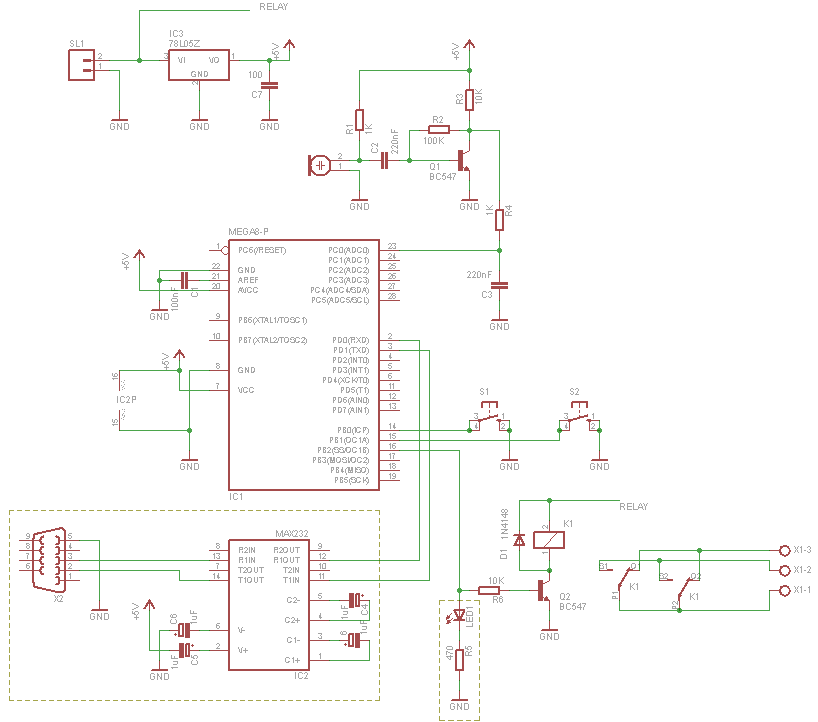
Arduino multi-mode lamp with soft touch switch

This Arduino-based project involves constructing a lamp with various light displays, including a color sequencer, dimming light, color chaser, and firelight, all controlled by a touch bar on the circuit board. The design adopts a minimalist approach, incorporating only a microcontroller, LEDs, a few resistors, and some capacitors, all for under $10, along with the necessary connecting hardware. The circuit utilizes three common-anode RGB Piranha type LEDs, each containing three individual LEDs within its housing. Each color requires a specific dropping resistor: 220 ohms for green and blue, and 330 ohms for red. Additionally, a small LED can be included with a 1k-ohm resistor as an indicator. The microcontroller used is the ATMega-328, which is priced around $5. A 16 MHz resonator, available for approximately 35 cents, is also required. The software development and testing are conducted using the Arduino platform, necessitating a suitable host. Various boards, such as the Arduino Nano, Boarduino, and RBBB (Really Bare Bones Board), have been successfully utilized. It is advisable to place the microcontroller in a socket; in this case, two 16-pin sockets are used end-to-end, resulting in some unused pins since the ATmega chip has only 28 pins. After completing the preliminary wiring, the circuit and programming are tested via jumpers connected to the RBBB, ensuring correct wiring before finalizing the microcontroller installation. The use of Teflon wire is a significant advantage, as it withstands high temperatures and can be routed close to soldered components. Teflon wire is also available in silver-plated variants, allowing for the use of thinner gauge wires (#28) while still handling the required current. These wires can be sourced from eBay. The wiring at the front serves as the touch sensor, where the program measures the voltage drop between the wires to detect touch. It can differentiate between a tap, press, or hold, which is then utilized to control the light patterns.
The circuit design focuses on integrating the ATMega-328 microcontroller, which serves as the central processing unit for controlling the light displays. The microcontroller interfaces directly with the RGB LEDs, allowing for dynamic color changes and effects. The common-anode configuration of the RGB LEDs necessitates careful selection of resistor values to ensure proper current limiting for each color channel, preventing damage to the LEDs. The touch bar is implemented using a capacitive touch sensing technique, where the microcontroller detects changes in capacitance when a finger approaches or touches the sensor area. This allows for a user-friendly interface to switch between different lighting modes.
The development process includes setting up the Arduino IDE for programming the ATMega-328. The software handles the logic for each lighting effect, utilizing timers and interrupts to manage the timing of light changes based on user input from the touch sensor. The circuit's minimalist design not only reduces costs but also simplifies assembly and troubleshooting. The incorporation of Teflon wire enhances the reliability of the connections, particularly in compact spaces where heat may be a concern.
Overall, this project exemplifies a cost-effective approach to creating an interactive lamp with multiple lighting options, leveraging the capabilities of the Arduino platform and the flexibility of the ATMega-328 microcontroller. The thoughtful selection of components and design considerations ensures a functional and engaging user experience.In this Arduino-based project, we will build a lamp with multiple light displays: color sequencer, dimming light, color chaser, firelight all selected by a touch bar on the circuit board. We will be going the minimalist way for this project, filling the board with just a microchip, the LEDs, a handful of resistors and some capacitors, all for
under $10, along with the necessary connecting hardware. The circuit will be using 3 RGB LEDs. These arecommon-anodePiranha type available here and contains three LEDs within its body. Each color will need a single dropping resistor (220-ohm for green and blue and 330-ohm for Red). We can also add a small LED with a 1k-ohm as an indicator. The IC we are using is an ATMega-328 microchip, available for about $5 here You will also need a 16Mhzresonatorfor about 35c, also available at the same site. The development and testing of the software is done using the Arduino system, so a suitable host` is necessary.
I`ve used an Arduino Nano`, a Boarduino and a RBBB board and they all work fine. It is averygood idea to put the microchip in a socket. Here, I`ve used 2 x 16-pin sockets end-to-end, because that is what I have available The ATMel chip only has 28-pins so we`ll have a few empty sockets on the end. After I`ve done the preliminary wiring, the circuit (and programming) is tested through jumpers connected to the host`, an RBBB (Really Bare Bones Board), also from Modern Devices.
This lets me make sure the wiring is correct before we commit the Microchip. A major effort-saver is the use of Teflon wire, which does not melt even when routed close to soldered parts. Teflon wire is also available silver-plated which allows me to use thinner wires (#28) and still handle the current.
These wires can be found here on eBay. The wiring at the front is used as the touch sensor. The program measures the voltage drop between the wires and can tell if it is touched. The duration is measured and we can tell if it is a tap, a press or a hold, and the program uses it to control the light patterns. 🔗 External reference
The circuit design focuses on integrating the ATMega-328 microcontroller, which serves as the central processing unit for controlling the light displays. The microcontroller interfaces directly with the RGB LEDs, allowing for dynamic color changes and effects. The common-anode configuration of the RGB LEDs necessitates careful selection of resistor values to ensure proper current limiting for each color channel, preventing damage to the LEDs. The touch bar is implemented using a capacitive touch sensing technique, where the microcontroller detects changes in capacitance when a finger approaches or touches the sensor area. This allows for a user-friendly interface to switch between different lighting modes.
The development process includes setting up the Arduino IDE for programming the ATMega-328. The software handles the logic for each lighting effect, utilizing timers and interrupts to manage the timing of light changes based on user input from the touch sensor. The circuit's minimalist design not only reduces costs but also simplifies assembly and troubleshooting. The incorporation of Teflon wire enhances the reliability of the connections, particularly in compact spaces where heat may be a concern.
Overall, this project exemplifies a cost-effective approach to creating an interactive lamp with multiple lighting options, leveraging the capabilities of the Arduino platform and the flexibility of the ATMega-328 microcontroller. The thoughtful selection of components and design considerations ensures a functional and engaging user experience.In this Arduino-based project, we will build a lamp with multiple light displays: color sequencer, dimming light, color chaser, firelight all selected by a touch bar on the circuit board. We will be going the minimalist way for this project, filling the board with just a microchip, the LEDs, a handful of resistors and some capacitors, all for
under $10, along with the necessary connecting hardware. The circuit will be using 3 RGB LEDs. These arecommon-anodePiranha type available here and contains three LEDs within its body. Each color will need a single dropping resistor (220-ohm for green and blue and 330-ohm for Red). We can also add a small LED with a 1k-ohm as an indicator. The IC we are using is an ATMega-328 microchip, available for about $5 here You will also need a 16Mhzresonatorfor about 35c, also available at the same site. The development and testing of the software is done using the Arduino system, so a suitable host` is necessary.
I`ve used an Arduino Nano`, a Boarduino and a RBBB board and they all work fine. It is averygood idea to put the microchip in a socket. Here, I`ve used 2 x 16-pin sockets end-to-end, because that is what I have available The ATMel chip only has 28-pins so we`ll have a few empty sockets on the end. After I`ve done the preliminary wiring, the circuit (and programming) is tested through jumpers connected to the host`, an RBBB (Really Bare Bones Board), also from Modern Devices.
This lets me make sure the wiring is correct before we commit the Microchip. A major effort-saver is the use of Teflon wire, which does not melt even when routed close to soldered parts. Teflon wire is also available silver-plated which allows me to use thinner wires (#28) and still handle the current.
These wires can be found here on eBay. The wiring at the front is used as the touch sensor. The program measures the voltage drop between the wires and can tell if it is touched. The duration is measured and we can tell if it is a tap, a press or a hold, and the program uses it to control the light patterns. 🔗 External reference





